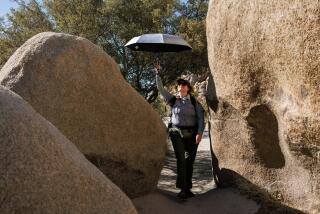A MEETING AT THE SUMMIT : Rock Climbers Need to Learn the Ropes to Prepare for a Safe and Easy Ascent
So you want to learn how to rock climb, but you’re not quite sure where to begin? Well, let’s start with some basic guidelines:
One, don’t try to fire a route too soon--you’ll be sure to take a whipper.
Two, if getting a gobi or two scares you, take a route with more chickenheads.
Three, don’t be a poser. Most of them are Gumbys, anyway.
Confused? Don’t be. You’ll catch on soon enough.
“Anyone can climb--it’s a natural human instinct,” said Tommy Duvall of the North Face mountaineering company. “We all climbed trees as boys and girls. Now it’s just a matter of regaining your confidence.”
Although some think of rock climbing as a mess of ropes and hooks, it actually involves two fields of careful, well-planned groups of maneuvers: free climbing and aid climbing.
A free climber uses hands, feet and fingers to push himself up the route. A rope is used only to catch a climber who falls.
Bouldering and free-soloing are two forms of free climbing. Bouldering involves climbing short, quick routes, usually not more than 25 feet long, and is considered the least dangerous method. Ideal for beginners, bouldering offers rudimentary muscle development as well as technical problems to practice.
Free-soloing uses no ropes, anchoring devices or safety equipment. The climber travels the route using only his strength, tenacity and experience. Although many consider free soloing to be the purist form of climbing, it is by far the most dangerous.
An aid climber uses bolts and other anchoring methods to hang his rope above his head. Instead of climbing only with hands or feet, the aid climber uses the rope to pull himself up. Most aid routes are too radical for basic free climbing.
One of the best ways to get started is by taking a course through a reputable rock climbing school. One of the most popular, Yosemite Mountaineering School, offers a one-day beginner’s lesson taught at Puppy Dome, a 70-foot-high rock consisting of simple routes.
On Puppy Dome, climbers learn the difference between a mantle--a move similar to pushing yourself out of a swimming pool--and a crack--using feet, fingers, or hands to wedge your body up and along the route.
The two basics of rope handling are next. Belaying involves the feeding and taking up of rope to the climbers. Rappelling involves slowly lowering yourself down the rope, walking backward down the rock to the ground. Reckless or rushed repelling is one of the biggest reasons climbers are injured or killed, according to the journal Climbing Accidents of North America.
Next are more advanced holds, including foot and hand jams, which position a part of the body into a crevice of the rock. As the hand or foot locks into the crevice, the climber is in a better position to pull his own weight.
Toe and finger jams also are used, the most difficult being a one-finger finger jam on an overhang where there is nothing for your feet to hold on to. Most often, the name of this move is experience.
Off-width holds are those used when the crack is too big for the hand, but too small for body. They’re often uncomfortable, and uncomplimentary to a climber’s style, but often need to be used.
Once you have mastered the basic moves, don’t run for the big rocks, Duvall said. Develop your skills at many gentler climbing areas, such as those that can be found in Orange County.
Randy Vogel, author of seven rock climbing guide books including The Hunk Guide to Orange County, charts many of the area’s better climbs.
These include:
--Turtle Rock, at the intersection of Campus and Turtle Rock Drives in Irvine, a good bouldering rock for beginners, Vogel says.
--Pirates’ Cove, at Corona del Mar State Beach in Corona del Mar. Known simply as “the beach” to local climbers, Pirates’ Cove offers a wide variety of bouldering routes, from roofs to straight cliffs to rocky knolls. Climbers often congest the area, so climb elsewhere during weekends or summer.
--Hart Park of Orange. The retaining walls on the park’s west side can challenge all levels of climbers. Some of the most difficult climbs are long, traverse routes, guaranteeing a good workout for even advanced climbers.
--The Ortega Highway rock region, located 21.5 miles east of I-5, offers many challenging problems, including long, narrow cracks as well as solid granite face climbs. The best climbing is done in dry weather, away from the Falls area. The Lost Arrow, a free-standing pinnacle above the falls, is a moderately difficult climb. Ziggy Boulders, located along the stream bed, offers short climbs, good for beginners. The Finger Crack is an expert rope route.
Outside Orange County, Joshua Tree National Monument ranks as one of the world’s most popular climbing regions. It has more than 2,000 established routes. Just northeast of Idyllwild, in the Fern Valley, Tahquitz (1,000 feet high) and Suicide Rock (400-feet) together offer more than 300 climbs from beginner to expert.
Many of these areas are not authorized for climbing, and should not be attempted without the permission from the landowner or proper authorities.
Now, don’t try to fire a route too soon--in other words, don’t try to do climb beyond your ability. Otherwise, you might take a fall--a whipper.
Also, don’t let a few scrapes or scratches (gobis) get you down. They come with the sport, and are quickly forgotten once the ascent is made. But if you still hate to get scratched, wear gloves, thick socks, and knee pads, or choose a route featuring many easy, rounded holds (chickenheads).
And don’t spend hundreds or even thousands of dollars on newfangled, ultra-high-tech equipment or put on slick, colorful Lycra tights--as posers do--until you become an expert.
Though rock climbing is not a low-budget sport--most beginners can get completely and safely outfitted for about $500--it offers the freedom from chic fashions. Cotton martial-arts pants and shorts and plain white T-shirts are the fashionable choice of experts. Those who expand their climbing wardrobe quicker than they expand their climbing skills are often inept climbers--otherwise known as Gumbys.
And when climbing rocks, it’s better to be pokey than Gumby.
More to Read
Sign up for The Wild
We’ll help you find the best places to hike, bike and run, as well as the perfect silent spots for meditation and yoga.
You may occasionally receive promotional content from the Los Angeles Times.






